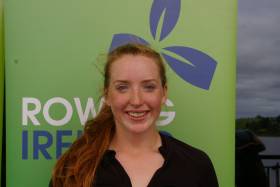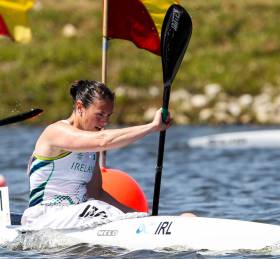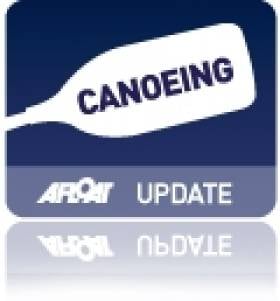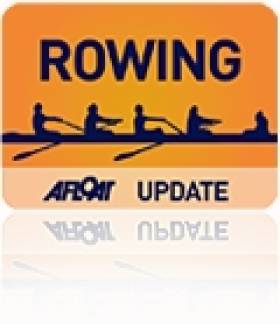Displaying items by tag: medal
Hegarty (19) Takes Bronze Medal at International Rowing Regatta
#Rowing: Emily Hegarty took a bronze medal at the Memorial Paolo d’Aloja international regatta in Piediluco in Italy this morning. The UCC woman, who is 19, showed great belief in herself to take third place and hold it in a race dominated by Diana Dymchenko of the Ukraine. Lina Saltyte of Lithuania, an established international, took the silver.
Memorial Paolo d’Aloja International Regatta, Piediluco, Italy (Irish interest)
Sunday
Women
Single Sculls – A Final: 1 Ukraine (D Dymchenko) 7:52.35, 2 Lithuania (L Saltyte) 8:11.90, 3 Ireland (E Hegarty) 8:14.76.
Paul O'Donovan Takes Bronze Medal in Top-Class New Zealand Final
#Rowing: Paul O’Donovan took on some of the top heavyweight rowers in the world and took a bronze medal at the New Zealand Rowing Championships today.
The Skibbereen man, who is the world lightweight single sculls champion, finished third in an open weight race won by Robbie Manson, who has set the world’s fastest time. Mahe Drysdale, the Olympic champion, was fifth.
Earlier the Skibberen four of Gary O’Donovan, Paul O’Donovan, Mark O’Donovan and Shane O’Driscoll finished third in the Premier four.
Max Murphy of UCD won a gold as part of a Waikato senior four, while Kevin Neville of NUIG took silver in a senior quadruple.
New Zealand Rowing Championships, Lake Karapiro, Day Five (Irish interest)
Men
Four – Premier
A Final: 1 North Shore One 5:55.33, 2 West End One 5:57.50, 3 Skibbereen (G O’Donovan, P O’Donovan, M O’Donovan, S O’Driscoll) 5:58.82.
Senior
Final: 1 Waikato (3 M Murphy) 6:32.67.
Sculling, Quadruple – Senior
A Final: 2 Nelson (3 K Neville) 6:31.86
Single – Premier
A Final: 1 Central RPC (R Manson) 7:19.48, 2 Southern RPC (J Storey) 7:22.89, 3 Skibbereen (P O’Donovan) 7:23.92.
Senior – B Final: 1 Wairau (K Neville) 7:23.73.
Jenny Egan Takes Third World Cup Medal in China
#Canoeing: Ireland's Jenny Egan finished third in the canoe marathon World Cup race over 26.2 kilometres in Shanghai today. This was the final race of the International Canoe Federation series in Shaoxing and Shanghai. Egan took a silver and a bronze in the first and second races. The three medals brings her tally of medals in marathon events this year to six.
Egan Takes Second World Cup Medal in China
#Canoeing: Jenny Egan took bronze at the canoe marathon World Cup in Shanghai in China. Kristina Bedek of Serbia won the 3.6 kilometre K1 race, with Lizzie Broughton of Britain and Egan filling the next two slots in a close finish. Egan had taken silver on Monday at the World Cup in Shaoxing.
Ireland also had another good finish in Shanghai. Barry Watkins took fourth in the men’s race.
Jenny Egan Takes Bronze Medal at World Marathon Championships
#Canoeing: Ireland’s Jenny Egan took a bronze medal in the K1 at the Canoe Marathon World Championships in Pietermaritzburg in South Africa. Lani Belcher, who competes for Britain, took gold at the head of a group of three which broke away from the rest of the field. Vanda Kiszli of Hungary took silver.
Egan’s World Championship medal capped a season in which she won gold and bronze in the K1 5,000 at canoe sprint World Cup events.
Rónán Ó Foghladha took fifth in the men’s junior K1.
Canoe Marathon World Championships, Pietermaritzburg, South Africa (Irish interest)
Men - K1: 19 B Watkins 2:15.26; 24 P Egan 2:19.07. Junior: 5 R Foley 1:45.48.
Women – K1: 1 Britain (L Belcher) 2 hrs 5 min 04 seconds, 2 Hungary (V Kiszli) 2:05.10, 3 Ireland (J Egan) 2:05.39; 17 A Smith 2:17.20
#CANOEING: Jenny Egan brought Ireland a first senior medal at the European Canoe Sprint Championships when she took bronze in the Women’s K1 5,000 metres in Racice in the Czech Republic today. Egan, from the Salmon Leap club in Leixlip, was part of a successful breakaway at 1,000 metres with Maryna Litvinchuk of Belarus, who took gold, and Irene Burgo of Italy, the silver medallist. Less than two-thirds of a second divided the three.
Ireland paracanoeist Patrick O’Leary finished fourth in his KL3 200 metre final. Robert Oliver of Britain took gold. O’Leary was just a third off a second of taking bronze.
European Canoe Sprint Championships, Racice, Czech Republic (Selected Results; Irish interest)
Saturday
Men
K2 200 – Heat Three (First Three to A Final; 4-7 to B Final; rest out): 1 Serbia 31.676; 8 P Egan, S Dobrovolskis 34.808.
C1 200 - Heat Three (Winner to Final; second to seventh to semi-final): 1 Portugal (H Silva) 39.236; 7 A Jezierski 43.220. Semi-Final: Jezierski did not start.
K1 200 – Heat Two: 6 T Brennan 37.596. Semi-Final (First Three to A Final, 4-7 to B Final): 1 Latvia (A Rumjancevs) 36.072; 7 T Brennan 37.852
Paracanoe KL3 – A Final: 1 Britain (R Oliver) 40.88; 4 P O’Leary 42.536.
Women
K1 200 – Heat Three (Winner to Final; second to seventh to semi-final): 1 Serbia (N Moldovan) 40.236; 7 J Egan 43.384. Semi-Final (First Three to A Final, 4-7 to B Final): 1 Russia (N Podolskaya) 42.196; 7 Egan 45.344.
Sunday
Men
K1 200 – B Final: 5 T Brennan (14th overall)
K1 5,000 – A Final: 18 P Egan 22:58.09.
Women
K1 5,000 – A Final: 1 Belarus (M Litvinchuk) 22 mins 19.25 seconds, 2 Italy (I Burgo) 22:19.68, 3 Ireland (J Egan) 22 mins 19.9 seconds.
K1 500 – B Final 6 J Egan 2:00.376. (15th overall)
K1 200 – B Final: 7 J Egan 44.896 (16th overall)
#ROWING: Sanita Puspure lifted Ireland to the podium at the European Rowing Championships in Belgrade in Serbia today. In a brilliant final of the women’s single sculls, Puspure started well and stayed up with the leaders right through the race. In a thrilling final 50 metres Mirka Knapkova, the Olympic champion battled Puspure to hold on to the lead, and then Puspure was just edged out of silver by a stunning finish by Chantal Achterberg of the Netherlands. There was just two hundredths of a second between silver and bronze – and Puspure was just three tenths of a second behind gold medal winner Knapkova.
European Rowing Championships, Belgrade, Serbia (Irish interest; Selected Results):
Men
Lightweight Four – A Final: 1 Denmark 6:08.81, 2 Britain (P Chambers, R Chambers, M Aldred, C Bartley) 6:10.97, 3 France 6:12.81.
Single Sculls – A Final: 1 Czech Republic (O Synek) 6:54.95; 6 Britain (A Campbell) 7:02.92
Women
Pair – A Final: I Britain (H Glover, P Swann) 7:03.620, 2 Romania (C Grigoras, L Oprea) 7:08.52, 3 The Netherlands (A Jorritsma, H Boers) 7:10.56, 4 Ireland (L Kennedy, L Dilleen) 7:12.42, 5 Croatia 7:23.66, 6 Germany.
Double Sculls – B Final (Places 7 to 10): 1 Czech Republic (L Antosova, A Zabova) 7:01.76, 2 Italy 7:05.18, 3 Austria 7:09.22
4 Ireland (M Dukarska, E Moran) 7:13.39.
Single Sculls – A Final: 1 Czech Republic (M Knapkova) 7:42.74,
2 Netherlands (C Achterberg) 7:43.02, 3 Ireland (S Puspure) 7:43.04; 4 Austria 7:44.97, 5 Russia 7:49.23, 6 Germany 7:54.5.
O'Donovan Completes Medal Haul For Ireland Rowing Team
#ROWING: Paul O’Donovan set an excellent time and took a bronze medal at the first international regatta of the season for the Ireland team. The Skibbereen lightweight sculler was not far off gold in a tight finish which saw him finish in 7:03 at the Memorial Paolo d’Aloja in Piediluco in Italy today. All four Ireland crews which competed at the regatta today took medals.
Lambe Takes Silver Medal at World University Rowing Championships
# ROWING: Ireland’s Claire Lambe took silver at the World University Rowing Championships in Kazan in Russia this morning. Kirsten McCann of South Africa got ahead of her at the start and maintained the lead under pressure from Lambe to take gold.
Lambe, a UCD student, was capping off a good season in the lightweight single sculls: she took fourth in World Under-23 Championships and 11th in the senior World Championships.
Ireland’s Niall Kenny finished fifth in his A Final of the lightweight single sculls and the women’s four were sixth in theirs.
World University Rowing Championships, Kazan, Russia – Day Three (Irish interest)
Men
Lightweight Single Sculls – A Final: 1 Hungary (P Galambos) 6:58.78, 2 Poland (BS Lesniak) 6:58.84, 3 Switzerland (M Schmid) 7:02.81; 4 Italy 7:07.16, 5 Ireland (N Kenny) 7:09.96, 6 Belgium 7:13.25.
Women
Four – A Final: 1 Russia 6:45.22, 2 Netherlands 6:55.02, 3 Poland 6:56.92, 4 Ukraine 7:02.56, 5 New Zealand 7:05.90, 6 Ireland (H Lavery, E Kerrigan, A Greene, C McIlwaine) 7:09.00.
Lightweight Single Sculls – A Final: 1 South Africa (K McCann) 7:38.47, 2 Ireland (C Lambe) 7:43.19, 3 Netherlands (NE Van Hoogenhuijze) 7:53.39; 4 Poland 8:01.04, 5 New Zealand 8:03.29, 6 Czech Republic 8:07.36.
Ireland So Close to Second Medal at Lucerne World Cup
Ireland came within 1.38 seconds of adding a second bronze medal to Siobhan McCrohan's at the World Cup rowing regatta at Lucerne today. The lightweight quadruple scull of Shane O’Driscoll, Niall Kenny, Peter Hanily and Justin Ryan were passed in the closing stages by Denmark when they seemed set to take third in this A Final. Germany won the race, with Italy second.
World Cup Regatta, Lucerne – Day Two (Irish interest)
Men
Lightweight Quadruple Scull – A Final: 1 Germany 6:03.19, 2 Italy 6:05.84, 3 Denmark 6:07.28; 4 Ireland 6:08.66, 5 Switzerland 6:09.61, 6 Norway 6:18.37.
Lightweight Double Scull – D Final (places 19 to 24): 1 Hungary 6:36.15, 2 Ireland 6:43.77, 3 Sweden 6:44.75.
Women
Double Scull – Semi-Final (First Three to A Final; rest to B Final): 1 Australia 6:54.22, 2 Ukraine 6:56.73, 3 Poland 6:58.30; 4 Belarus 7:07.73, 5 Romania 7:09.95, 6 Ireland (L Dilleen, S Puspure) 7:15.75
Lightweight Double Scull – C Final (Places 13 to 18): 1 Austria 7:14.01; 5 Ireland (S Dolan, C Lambe) 7:19.47
Lightweight Single Scull – Semi-Final One (First Three to A Final; rest to B Final): 1 Switzerland (P Weisshaupt) 7:56.1, 2 Ireland (S McCrohan) 7:58.65, 3 Belgium (J Hammond) 8:03.22; 4 Japan 8:09.31, 5 Canada 8:09.80, 6 Hong Kong 8:14.50. A FINAL: 1 Greece (A Tsiavou) 7:47.78, 2 Switzerland (P Weisshaupt) 7:51.39, 3 Ireland (S McCrohan) 7:54.86; 4 Belgium (J Hammond) 7:55.17, 5 Poland 7:59.80, 6 Netherlands (M-A Frenken) 8:02.57.





































































